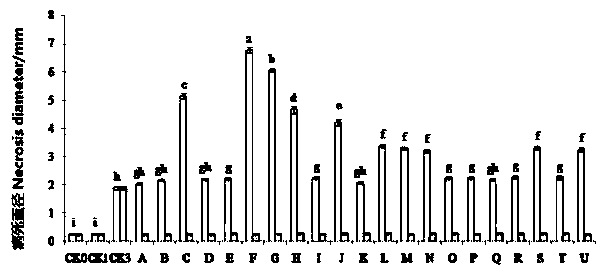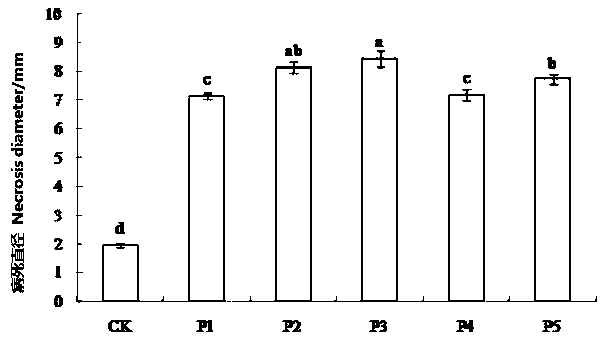Method used for preventing alien weed Alternanthera philoxeroides with pathogenic fungus
A kind of technology of Echinochloa japonicus and pathogenic fungi, applied in the direction of fungi, botanical equipment and methods, chemicals for biological control, etc., can solve the problems of unfavorable control and no effect, and achieve simple equipment, simple operation, The effect of strong stability
- Summary
- Abstract
- Description
- Claims
- Application Information
AI Technical Summary
Problems solved by technology
Method used
Image
Examples
Embodiment 1
[0026] The strong pathogenic bacteria strain J-14 with a diameter of 6 mm was transferred to potato agar medium (PDA), lotus leaf decoction medium (ADA), yeast extract powder peptone glucose agar medium (YPD), 1 %Polysorbate 80-corn agar medium (TCA), Sabouraud agar medium (SDLA), Chapeauer's medium (CDA) and Sabouraud dextrose agar medium (SDA) on 7 medium plates, placed at 25± Cultivate in the dark at 1°C in a biochemical incubator, measure the diameter of the colony after 5 days, then gently scrape off the spores with a glass slide, add an appropriate amount of sterile water to prepare a spore suspension, and count the spores with the hemocytometer method under a microscope output. Five replicates were set up for each treatment, and the results are shown in Table 1.
[0027] Table 1 shows that Alternaria is better on bacterium colony growth (P6 1, significantly higher than its sporulation production on other media (P<0.05), followed by 1% polysorbate 80-corn agar medium (T...
Embodiment 2
[0032] After dissolving the Alternaria toxin with a small amount of ethyl acetate (concentration: 2%), prepare 125, 250, 500, 1000, 2000 μg / mL toxin solutions with distilled water, respectively. The pathogenicity of the toxin to A. japonicus was detected by the needle-prick method of detached leaves. Select a healthy branch of A. japonicus without diseases and insect pests, take the third pair of leaves counted from the top down, rinse them with sterile water, absorb the water on the leaves with absorbent paper, and place them on a petri dish covered with a piece of wet filter paper. Gently puncture the epidermis of the leaves with a dissecting needle, drop 10 μL of the solution, and place it in a biochemical incubator at 25±1°C for dark cultivation. Measure the diameter of the lesion after 72 hours; at the same time, set the water control CK0 and 2% ethyl acetate Control CK1, each treatment was repeated 4 times, see the results figure 1 .
[0033] figure 1 It shows that Al...
Embodiment 3
[0035] After dissolving the Alternaria toxin with a small amount of ethyl acetate (concentration: 2%), a toxin solution with a concentration of 1000 μg / mL was prepared with distilled water. The pathogenicity of the toxins to the main symbiotic plants and common crops in the habitat of A. japonicus was detected by the acupuncture method of detached leaves. The treatment method of the leaves was the same as in Example 2, and then the grading statistics were carried out according to the diameter of the lesion. The pathogenicity grading standard is shown in Table 2, the statistical results are shown in Table 3.
[0036] Table 2 Pathogenicity level of Alternaria toxins to plants (acupuncture method of detached leaves)
[0037]
[0038] Table 3 shows that the toxin has strong pathogenicity to most symbiotic weeds of A. japonicus, but there are certain differences among different weeds. Among them, the toxin has the strongest pathogenicity to Imperata Imperata, Artemisia japonica...
PUM
 Login to View More
Login to View More Abstract
Description
Claims
Application Information
 Login to View More
Login to View More - R&D
- Intellectual Property
- Life Sciences
- Materials
- Tech Scout
- Unparalleled Data Quality
- Higher Quality Content
- 60% Fewer Hallucinations
Browse by: Latest US Patents, China's latest patents, Technical Efficacy Thesaurus, Application Domain, Technology Topic, Popular Technical Reports.
© 2025 PatSnap. All rights reserved.Legal|Privacy policy|Modern Slavery Act Transparency Statement|Sitemap|About US| Contact US: help@patsnap.com



